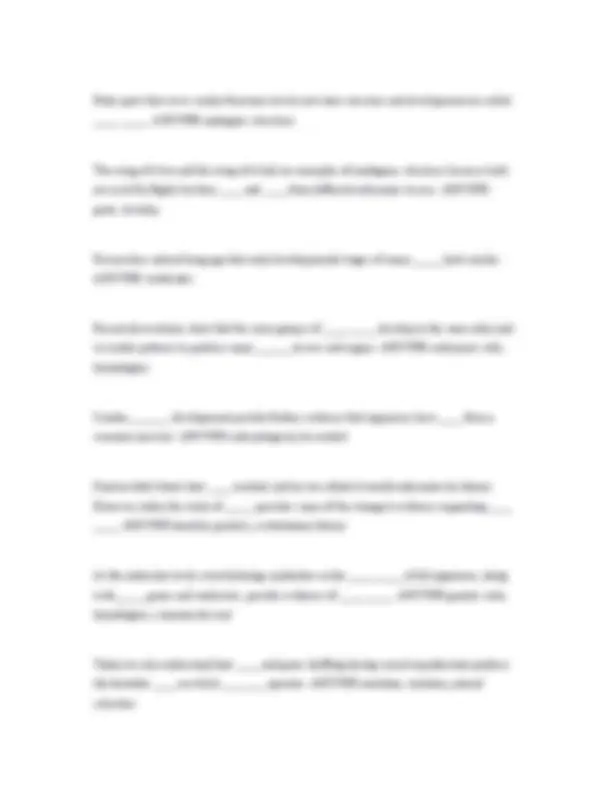





Study with the several resources on Docsity

Earn points by helping other students or get them with a premium plan


Prepare for your exams
Study with the several resources on Docsity

Earn points to download
Earn points by helping other students or get them with a premium plan
Community
Ask the community for help and clear up your study doubts
Discover the best universities in your country according to Docsity users
Free resources
Download our free guides on studying techniques, anxiety management strategies, and thesis advice from Docsity tutors
Biology 17.4 Evidence of Evolution Exam with Verified Solutions ______ is the study of where organisms live now where they and they ancestors lived in the past ANSWER Biogeography Patterns in the distribution of _____ and living _____, combined with information from ______, tell us how modern organisms evolved from their ancestors. ANSWER fossils, species, geology Darwin realized that closely related species can evolve ______ adaptations in different _______. ANSWER diverse, environments Darwin also realized that very distantly related species can evolve ______ adaptations if they live in similar _______. ANSWER similar, environments Darwin knew that for life to have ______ the way he thought it had, the Earth must be very _____. ANSWER evolved, old _____ and _____ had argued that the Earth was much older than people thought but they could not determine just how old. ANSWER Hutton, Lyell The discovery ______ and the technique of radioactive dating enabled
Typology: Exams
1 / 5

This page cannot be seen from the preview
Don't miss anything!




______ is the study of where organisms live now where they and they ancestors lived in the past ANSWER Biogeography Patterns in the distribution of _____ and living _____, combined with information from ______, tell us how modern organisms evolved from their ancestors. ANSWER fossils, species, geology Darwin realized that closely related species can evolve ______ adaptations in different _______. ANSWER diverse, environments Darwin also realized that very distantly related species can evolve ______ adaptations if they live in similar _______. ANSWER similar, environments Darwin knew that for life to have ______ the way he thought it had, the Earth must be very _____. ANSWER evolved, old _____ and _____ had argued that the Earth was much older than people thought but they could not determine just how old. ANSWER Hutton, Lyell The discovery ______ and the technique of radioactive dating enabled scientists to date rocks and determine that the Earth is about ______ years old - plenty of time for evolution by _____ _____ to take place. ANSWER radioactivity, 4.5 billion, natural selection Many recently discovered _____, now show clearly how modern species evolved from _____ _____. ANSWER fossils, extinct ancestors
So many intermediate life forms have been found in the ____ ____ that it is difficult to tell where one group begins and another ends. ANSWER fossil record By Darwin's time, scientists had noted that the bones in all ____ limbs ______ each other to a surprising degree. ANSWER vertebrate, resembled Similar structures, like the bones of vertebrate limbs, that are shared by related species and have been inherited from a common ancestor are called _____ _____. ANSWER homologous structures _____ _____ explains the existence of homologous structures adapted to _____ purposes as the result of ____ ___ _____ from a common ancestor. ANSWER Evolutionary theory, different, descent with modification Similarities and differences among ____ _____ help determine how recently species shared a _____ ____. ANSWER homologous structures, common ancestor The key to identifying homology is ____ _____ and ______ during development, not ____ _____. ANSWER common structure, origin, common function _____ _____ are inherited from ancestors, but have lost much of their original size and function. ANSWER Vestigial structures One example of a vestigial structure is the ______ of dolphins ANSWER hipbones One proposed reason why ____ _____ continue to exist in an organism is that they do not affect an organism's _____, so natural selection does not eliminate them. ANSWER vestigial structures, fitness
The ____ ____ is nearly identical in nearly all organisms, which is powerful evidence that all organisms ____ from common ancestors. ANSWER genetic code, evolved In Darwin's day, biologists could only study similarities and differences in ____ they could see. Today, we know that ____ resulting from common ancestors shows up at the _____ level too. ANSWER structures, homology, molecular On spectacular example of homologous genes is a set of genes called ____ ____. These help determine the destinies of different ____ ___. ANSWER Hox genes, body parts _____ changes in Hox genes (or "master control genes") can produce _____ changes in the size and shape of the structures they control. ANSWER Small, dramatic At least some _____ ___ genes are found in almost all multicellular animals. This is further evidence that these genes have been _____ from ancient common ancestors. ANSWER homologous Hox, inherited The data that the _____ gathered on finch populations during the drought on the Galapagos showed a dramatic increase in ___ ____ over just a few years. ANSWER Grants, beak sizes The Grants documented that ____ _____ takes place in wild finch populations _____, and sometimes rapidly. ANSWER natural selection, frequently One of the Grants' colleagues calculated that it might take no more than 12 to 20 major droughts to change the ___ ____ of the finches enough to transform them into another ______. ANSWER break sizes, species
______ within a species increases a population's ability to adapt to, and survive, _____ change. ANSWER Variation, environmental Today evolutionary theory is vital to all biological and biomedical sciences, and is often called the ____ ____ ___ of the life sciences. ANSWER grand unifying theory